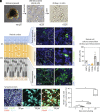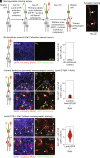Re-formation of synaptic connectivity in dissociated human stem cell-derived retinal organoid cultures
- PMID: 36598946
- PMCID: PMC9926218
- DOI: 10.1073/pnas.2213418120
Re-formation of synaptic connectivity in dissociated human stem cell-derived retinal organoid cultures
Abstract
Human pluripotent stem cell (hPSC)-derived retinal organoids (ROs) can efficiently and reproducibly generate retinal neurons that have potential for use in cell replacement strategies [Capowski et al., Development 146, dev171686 (2019)]. The ability of these lab-grown retinal neurons to form new synaptic connections after dissociation from ROs is key to building confidence in their capacity to restore visual function. However, direct evidence of reestablishment of retinal neuron connectivity via synaptic tracing has not been reported to date. The present study employs an in vitro, rabies virus-based, monosynaptic retrograde tracing assay [Wickersham et al., Neuron 53, 639-647 (2007); Sun et al., Mol. Neurodegener. 14, 8 (2019)] to identify de novo synaptic connections among early retinal cell types following RO dissociation. A reproducible, high-throughput approach for labeling and quantifying traced retinal cell types was developed. Photoreceptors and retinal ganglion cells-the primary neurons of interest for retinal cell replacement-were the two major contributing populations among the traced presynaptic cells. This system provides a platform for assessing synaptic connections in cultured retinal neurons and sets the stage for future cell replacement studies aimed at characterizing or enhancing synaptogenesis. Used in this manner, in vitro synaptic tracing is envisioned to complement traditional preclinical animal model testing, which is limited by evolutionary incompatibilities in synaptic machinery inherent to human xenografts.
Keywords: human pluripotent stem cells; photoreceptors; retinal organoid; synapses; trans-synaptic tracing.
Conflict of interest statement
The authors declare competing interests and have patent filings to disclose. D.M.G. has declared intellectual rights for production of 3D ROs through the Wisconsin Alumni Research Foundation, Madison, WI (US PTO No. 9,328,328). The authors have organizational affiliations and research support to disclose. D.M.G. has an ownership interest in and receives grant support from Opsis Therapeutics LLC, which has licensed the technology to generate ROs from hPSCs utilized in this publication. The terms of this arrangement have been reviewed and approved by the University of Wisconsin-Madison in accordance with its conflict-of-interest policies. All other authors declare no competing interests.
Figures



Similar articles
-
Robust generation of photoreceptor-dominant retinal organoids from porcine induced pluripotent stem cells.Stem Cell Reports. 2025 Apr 8;20(4):102425. doi: 10.1016/j.stemcr.2025.102425. Epub 2025 Mar 6. Stem Cell Reports. 2025. PMID: 40054472 Free PMC article.
-
Rabies virus-based barcoded neuroanatomy resolved by single-cell RNA and in situ sequencing.Elife. 2024 Feb 6;12:RP87866. doi: 10.7554/eLife.87866. Elife. 2024. PMID: 38319699 Free PMC article.
-
Three-Dimensional Retinal Organoids Facilitate the Investigation of Retinal Ganglion Cell Development, Organization and Neurite Outgrowth from Human Pluripotent Stem Cells.Sci Rep. 2018 Sep 28;8(1):14520. doi: 10.1038/s41598-018-32871-8. Sci Rep. 2018. PMID: 30266927 Free PMC article.
-
The Prospects for Retinal Organoids in Treatment of Retinal Diseases.Asia Pac J Ophthalmol (Phila). 2022 Jul-Aug 01;11(4):314-327. doi: 10.1097/APO.0000000000000538. Epub 2022 Aug 30. Asia Pac J Ophthalmol (Phila). 2022. PMID: 36041146 Free PMC article. Review.
-
Structural and Functional Characterization of Human Stem-Cell-Derived Retinal Organoids by Live Imaging.Invest Ophthalmol Vis Sci. 2017 Jul 1;58(9):3311-3318. doi: 10.1167/iovs.16-20796. Invest Ophthalmol Vis Sci. 2017. PMID: 28672397 Free PMC article. Review.
Cited by
-
Establishing Functional Retina in a Dish: Progress and Promises of Induced Pluripotent Stem Cell-Based Retinal Neuron Differentiation.Int J Mol Sci. 2023 Sep 4;24(17):13652. doi: 10.3390/ijms241713652. Int J Mol Sci. 2023. PMID: 37686457 Free PMC article. Review.
-
Therapeutic strategies for glaucoma and optic neuropathies.Mol Aspects Med. 2023 Dec;94:101219. doi: 10.1016/j.mam.2023.101219. Epub 2023 Oct 13. Mol Aspects Med. 2023. PMID: 37839232 Free PMC article. Review.
-
Micromolded honeycomb scaffold design to support the generation of a bilayered RPE and photoreceptor cell construct.Bioact Mater. 2023 Jul 31;30:142-153. doi: 10.1016/j.bioactmat.2023.07.019. eCollection 2023 Dec. Bioact Mater. 2023. PMID: 37575875 Free PMC article.
-
Microglia determine an immune-challenged environment and facilitate ibuprofen action in human retinal organoids.J Neuroinflammation. 2025 Apr 3;22(1):98. doi: 10.1186/s12974-025-03366-x. J Neuroinflammation. 2025. PMID: 40181459 Free PMC article.
-
Robust generation of photoreceptor-dominant retinal organoids from porcine induced pluripotent stem cells.Stem Cell Reports. 2025 Apr 8;20(4):102425. doi: 10.1016/j.stemcr.2025.102425. Epub 2025 Mar 6. Stem Cell Reports. 2025. PMID: 40054472 Free PMC article.
References
-
- Cajal S. R. y., Estructura de los centros nerviosos de las aves. Revista Trimestral de Histología Normal y Patológica, 1, 1–10 (1888).
-
- Jones B. W., Marc R. E., Retinal remodeling during retinal degeneration. Exp. Eye Res. 81, 123–137 (2005). - PubMed
-
- Quigley H. A., Glaucoma. Lancet 377, 1367–1377 (2011). - PubMed
Publication types
MeSH terms
Substances
Grants and funding
LinkOut - more resources
Full Text Sources
Research Materials
Miscellaneous

